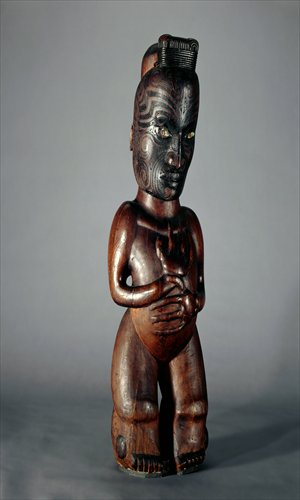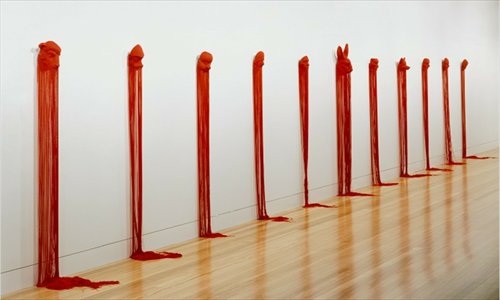Art to treasure

Although it is almost two years since the World Expo 2010 in Shanghai drew to a close at the end of October 2010, its architectural legacy lives on in a number of venues, most notably the highly acclaimed China Pavilion. And now this iconic red structure has been transformed into the city's latest art venue and has been rechristened the China Art Museum Shanghai.

The building covers 166,000 square meters with 64,000 square meters set aside for display purposes. The collection of the Shanghai Art Museum - formerly located on Nanjing Road West - has been incorporated into the venue, making it now the largest art museum in China. The museum opened its doors to the public on October 1, and aims to play a significant role in promoting the development of the arts in Shanghai and the country as a whole.

World-class works
To launch the new venture, an international exhibition features art treasures selected by five world-renowned museums: the British Museum, Rijksmuseum Amsterdam, Whitney Museum of American Art in New York, the Maison de Victor Hugo in Paris, and the Museum of New Zealand Te Papa Tongarewa in Wellington. The Consulate General of Mexico in Shanghai has also provided a series of works by the Mexican artist Javier Marin.
Highlights on show from the British Museum include a nude figure of the Egyptian seal bearer Tjetji (created between 2321BC and 2184BC), a sculpture of the kneeling Egyptian Pharaoh Rameses IV (created between 1153BC and 1147BC), and a stone relief featuring a winged protective spirit discovered in Iraq and which dates back to the Neo-Assyrian Period (935BC-612BC). Entitled Treasure: The Human Form, this sub-section of the exhibition displays a total of 19 priceless pieces from the London-based institution. The exhibits demonstrate perceptions of the human form created in different epochs and different areas from around the world.

Meanwhile, the Rijksmuseum Amsterdam, the national museum of the Netherlands, has lent two of its national treasures namely Portrait of Haesje Jacobsdr van Cleyburg by Rembrandt, and Woman in Blue Reading a Letter by Johannes Vermeer.
"It is a rare opportunity for domestic visitors to see such a large amount of world-class treasures in a single venue," said Tina Zhang, one of the two main curators of the exhibition. "It is the first time that these two Dutch pieces, and most of the British exhibits, will be seen in China."

Victor's spoils
Victor Hugo is a well-known figure among Chinese literature lovers, but few are aware that he was also a talented artist. The Maison de Victor Hugo has selected six of his ink paintings which evoke the landscapes seen in many traditional Chinese ink-and-wash paintings. "Visitors may find it interesting that Hugo even used coffee stains to touch up his paintings, just like some Chinese contemporary artists use tea stains in their ink painting works," Zhang added.
Along with the ink paintings, visitors can also appreciate Hugo's manuscripts, as well as artworks featuring Hugo himself and his acquaintances created by his fellow countrymen. Among them are a sculpture of Hugo by Auguste Rodin, and a portrait of Hugo's lover Juliette Drouet by the naturalist painter Jules Bastien-Lepage.
The section contributed by the Whitney Museum of American Art focuses on the revolutionary diversity of American painting over the last century. From Grant Wood, best-known for depictions of the rural American Midwest, to Andy Warhol, the leading figure of the 1960s pop art movement, and from Georgia O'Keeffe, renowned for her blend of abstraction and pictorialism, to other pop artists such as Roy Lichtenstein and Jasper Johns, these works illustrate emerging US art movements from the 1920s to the 1980s.

Contemporary talent
"Compared with the classic and traditional arts, contemporary art seems much more striking in terms of its visual effects and in that it employs a greater variety of materials and is presented in more diversified art forms," said Zhang, standing among the seven sets of installment works by New Zealand-based artists.
And it is here that visitors can appreciate Rainbow Country, a series of colorful wool-woven works by Ani O'Neil, which resemble the rainbows and colorful marine life associated with Oceania (a region centered on the 25,000 tropical islands in the Pacific Ocean). Other works by New Zealand artists feature a fusion of Maori, immigrant, and Oceanic culture.

This antipodean section also includes Chinese-Australian artist Yuk King Tan's Untitled (Red masks), which encapsulates several Chinese elements, such as red fabric, the Chinese zodiac, and typical Chinese Opera-style face makeup.
Mexican artist Marin's works have been displayed around the world for the past 30 years, including at the Mexico Pavilion during the Shanghai Expo. For this show, the country's consulate general has selected a number of Marin's sculptures and relief works, which all focus on the human body and organs. "Martin's pieces don't look glossy or delicate, and it's his distinctive way of carving that gives his sculptures life and energy," said Zhang.

Date: Until December 31, 9 pm to 5 pm (closed on Mondays)
Venue: China Art Museum Shanghai 中华艺术宫
Address: 161 Shangnan Road 上南路161号
Admission: Free, online reservation required (artshow.eastday.com for individual visitors and ticketing.exposhanghaigroup.com for group visitors. Both websites are only available in Chinese.)
Call 400-921-9021 for details